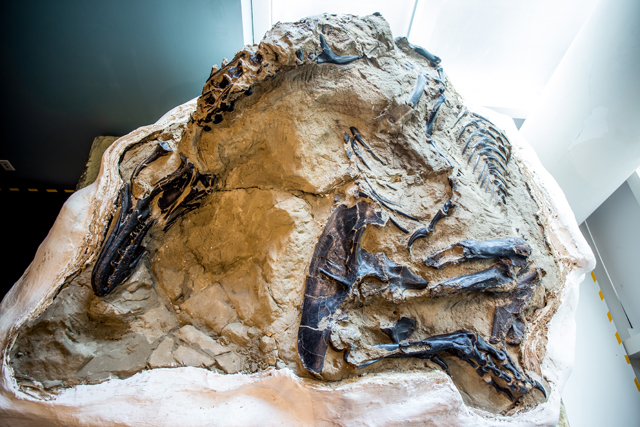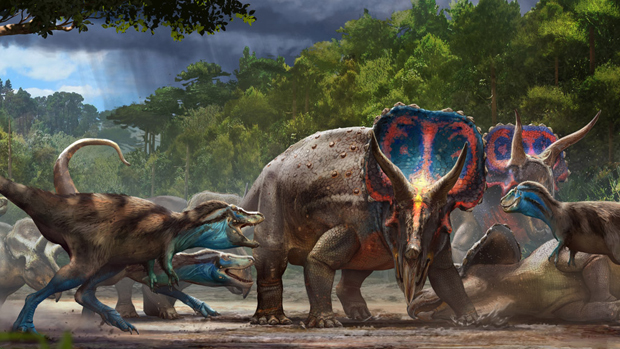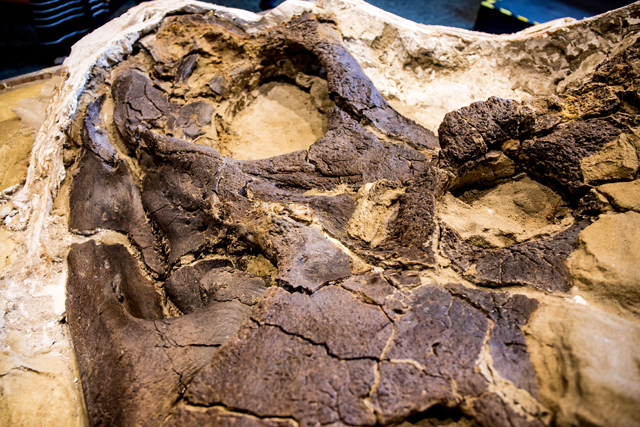North Carolina Museum of Natural Sciences Gets Amazing “Duelling Dinosaurs”
“Duelling Dinosaurs” Find Permanent Home
The famous “Duelling Dinosaurs” featuring a tyrannosaurid specimen closely associated with a large ceratopsid have found a permanent home at the North Carolina Museum of Natural Sciences. The fossils, discovered eroding slowly out of a hillside formed from the famous Hell Creek Formation deposits of Montana were once thought to represent a dwarf, lightweight species of Late Cretaceous tyrannosaurid – named Nanotyrannus and a new species of horned dinosaur, these days, most palaeontologists consider the largely articulated and heavily associated pair to represent a sub-adult Tyrannosaurus rex and a Triceratops.
“Duelling Dinosaurs”
Their acquisition on behalf of the Museum, by the not-for-profit Friends of the North Carolina Museum of Natural Sciences will permit palaeontologists access to study these amazing 66-million-year-old dinosaurs as well as allowing the general public to get up close and personal to two dinosaur fossils that could have ended up in the hands of a private collector.
Still Partially Entombed – The Tyrannosaurid Member of the “Duelling Dinosaurs”

Picture credit: Matt Zeher
Evidence of Predator/Prey Interaction
The fossils, only partially exposed and still protected by their burlap field jackets may represent the best-preserved skeletons of Triceratops and T. rex known to science. The huge blocks may contain evidence of a predator/prey interaction. The dinosaur carcasses have not been studied and remain entombed within sediment from the Montana hillside where they were discovered. Because of these rare burial conditions, each bone is in its natural position and Museum scientists will have access to biological data that is typically lost in the excavation and preparation processes.
Entombing sediment preserves extraordinary features such as body outlines, skin impressions and other soft tissues, as well as injuries and potential evidence of interaction, such as tyrannosaur teeth embedded in the bones of its ceratopsian companion.
A Life Reconstruction of “Duelling Dinosaurs”
Picture credit: Anthony Hutchings
Welcoming Important Specimens
Commenting on the arrival of these remarkable specimens, Jason Barron, chair of the Friends of the North Carolina Museum of Natural Sciences stated:
“It is an immeasurable honour to welcome these specimens as they take up permanent residence here at the Museum. Duelling Dinosaurs is a singular find; we are incredibly grateful to our supporters for making this a reality and allowing our visitors – in-person and virtual alike – to experience this journey with us.”
In conjunction with the fossil acquisition, design is nearing completion on a globally unique, behind-the-scenes visitor experience at the Museum in downtown Raleigh. The exhibit will be the first physical expansion of the Museum in over ten years and will build on its sustained leadership in public engagement with scientific research.
Part of the “Duelling Dinosaurs” Awaiting Further Study and Research
Picture credit: Matt Zeher
Providing New Opportunities to Learn About Iconic North American Dinosaurs
The acquisition of the “duelling dinosaurs” and the fact that they have a permanent home, will allow palaeontologists the opportunity to carefully study what has been described as one of the most astonishing vertebrate fossils ever found.
Dr Lindsay Zanno, head of palaeontology at the North Carolina Museum of Natural Sciences, is very excited at the prospect at being able to study these unique, associated fossils and commented:
“We have not yet studied this specimen; it is a scientific frontier. The preservation is phenomenal, and we plan to use every technological innovation available to reveal new information on the biology of T. rex and Triceratops. This fossil will forever change our view of the world’s two favourite dinosaurs. The way we have designed the entire experience — inviting the public to follow the scientific discoveries in real time and participate in the research — will set a new standard for museums.”
Everything Dinosaur acknowledges the assistance of a media release from the North Carolina Museum of Natural Sciences in the compilation of this article.
To read an article from 2013 about the auction of these fossils: D-Day for Important Dinosaur Fossils.
Visit the user-friendly Everything Dinosaur website: Prehistoric Animal Models and Gifts.



